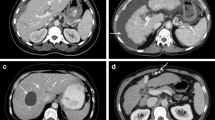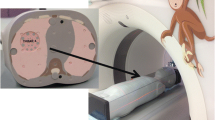Abstract
Purpose
To assess the radiation dose and image quality of routine dual energy CT (DECT) of the abdomen and pelvis performed in the emergency department setting, compared with single energy CT (SECT).
Materials and methods
Seventy-five consecutive routine contrast-enhanced SECT scans of the abdomen and pelvis meeting inclusion criteria were compared with 75 routine contrast-enhanced DECT scans matched by size and patient weight (within 10 lbs), performed on the same dual-source DECT scanner. Cohorts were compared in terms of radiation dose metrics of CT dose index (CTDIvol) and dose length product (DLP), objective measurements of image quality (signal, noise, and signal-to-noise ratio of a variety of anatomical landmarks), and subjective measurements of image quality scored by two emergency radiologists.
Results
Demographics and patient size were not statistically different between DECT and SECT cohorts. Both average scans CTDIvol and DLP were significantly lower with DECT than with SECT. Average scan CTDIvol for SECT was 14.7 mGy (± 6.6) and for DECT was 10.9 mGy (± 3.8) (p < 0.0001). Average scan DLP for SECT was 681.5 mGy cm (± 339.3) and for DECT was 534.8 mGy cm (± 201.9) (p < 0.0001). For objective image quality metrics, for all structures measured, noise was significantly lower and SNR was significantly higher with DECT compared with SECT. For subjective image quality, for both readers, there was no significant difference between SECT and DECT in subjective image quality for soft tissues and vascular structures, or for subjective image noise.
Conclusions
DECT was performed with decreased radiation dose when compared with SECT, demonstrated improved objective measurements of image quality, and equivalent subjective image quality.

Similar content being viewed by others
References
Rosen MP, Sands DZ, Longmaid HE III, Reynolds KF, Wagner M, Raptopoulos V (2000) Impact of abdominal CT on the management of patients presenting to the emergency department with acute abdominal pain. Am J Roentgenol 174(5):1391–1396
Larson DB, Johnson LW, Schnell BM, Salisbury SR, Forman HP (2011) National trends in CT use in the emergency department: 1995–2007. Radiology. 258(1):164–173
Wortman JR, Uyeda JW, Fulwadhva UP, Sodickson AD (2018) Dual-energy CT for abdominal and pelvic trauma. RadioGraphics. 38(2):586–602
Fulwadhva UP, Wortman JR, Sodickson AD (2016) Use of dual-energy CT and iodine maps in evaluation of bowel disease. RadioGraphics. 36(2):393–406
Darras KE, McLaughlin PD, Kang H, Black B, Walshe T, Chang SD et al (2016) Virtual monoenergetic reconstruction of contrast-enhanced dual energy CT at 70keV maximizes mural enhancement in acute small bowel obstruction. Eur J Radiol 85(5):950–956
Wortman JR, Bunch PM, Fulwadhva UP, Bonci GA, Sodickson AD (2016) Dual-energy CT of incidental findings in the abdomen: can we reduce the need for follow-up imaging? Am J Roentgenol. Jul 6:W1–W11
Botsikas D, Triponez F, Boudabbous S, Hansen C, Becker CD, Montet X (2014 Oct) Incidental adrenal lesions detected on enhanced abdominal dual-energy CT: can the diagnostic workup be shortened by the implementation of virtual unenhanced images? Eur J Radiol 83(10):1746–1751
Coursey CA, Nelson RC, Boll DT, Paulson EK, Ho LM, Neville AM et al (2010) Dual-energy multidetector CT: how does it work, what can it tell us, and when can we use it in abdominopelvic imaging? 1. RadioGraphics. 30(4):1037–1055
Ho LM, Marin D, Neville AM, Barnhart HX, Gupta RT, Paulson EK et al (2012) Characterization of adrenal nodules with dual-energy CT: can virtual unenhanced attenuation values replace true unenhanced attenuation values? Am J Roentgenol 198(4):840–845
Henzler T, Fink C, Schoenberg SO, Schoepf UJ (2012) Dual-Energy CT: radiation dose aspects. Am J Roentgenol 199(5_supplement):S16–S25
Purysko AS, Primak AN, Baker ME, Obuchowski NA, Remer EM, John B et al (2014) Comparison of radiation dose and image quality from single-energy and dual-energy CT examinations in the same patients screened for hepatocellular carcinoma. Clin Radiol 69(12):e538–e544
Pinho DF, Kulkarni NM, Krishnaraj A, Kalva SP, Sahani DV (2013) Initial experience with single-source dual-energy CT abdominal angiography and comparison with single-energy CT angiography: image quality, enhancement, diagnosis and radiation dose. Eur Radiol 23(2):351–359
Jepperson MA, Cernigliaro JG, Ibrahim E-SH, Morin RL, Haley WE, Thiel DD (2015) In vivo comparison of radiation exposure of dual-energy CT versus low-dose CT versus standard CT for imaging urinary calculi. J Endourol 29(2):141–146
Schmidt D, Söderberg M, Nilsson M, Lindvall H, Christoffersen C, Leander P (2017) Evaluation of image quality and radiation dose of abdominal dual-energy CT. Acta Radiol 19:028418511773280
Kanal KM, Butler PF, Sengupta D, Bhargavan-Chatfield M, Coombs LP, Morin RL (2017) U.S. Diagnostic reference levels and achievable doses for 10 adult CT examinations. Radiology. 284(1):120–133
Yu L, Primak AN, Liu X, McCollough CH (2009) Image quality optimization and evaluation of linearly mixed images in dual-source, dual-energy CT. Med Phys 36(3):1019–1024
Author information
Authors and Affiliations
Corresponding author
Ethics declarations
Conflicts of interest
The authors declare they have no conflict of interest.
Dr. Sodickson is Principal Investigator on a Siemens institutional research grant.
Additional information
Publisher’s note
Springer Nature remains neutral with regard to jurisdictional claims in published maps and institutional affiliations.
Rights and permissions
About this article
Cite this article
Wortman, J.R., Shyu, J.Y., Dileo, J. et al. Dual-energy CT for routine imaging of the abdomen and pelvis: radiation dose and image quality. Emerg Radiol 27, 45–50 (2020). https://doi.org/10.1007/s10140-019-01733-9
Received:
Revised:
Accepted:
Published:
Issue Date:
DOI: https://doi.org/10.1007/s10140-019-01733-9




